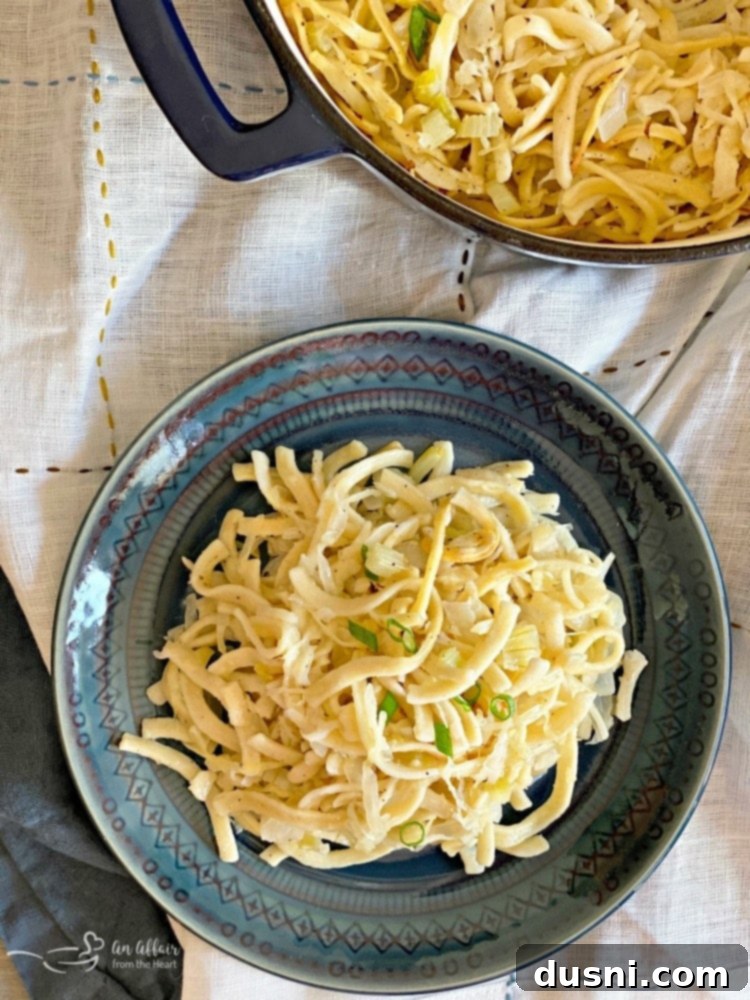Classic Polish Noodles & Sauerkraut Casserole: A Hearty, Meatless Comfort Food (Kluski Kapusta Kiszona)
Indulge in a beloved Polish tradition with this delightful Kluski Noodles & Sauerkraut casserole. Featuring tender kluski noodles, savory onion, crisp celery, and tangy sauerkraut, all pan-fried in rich butter and then baked to golden perfection, this meatless dish offers a satisfying taste of authentic Polish comfort food.
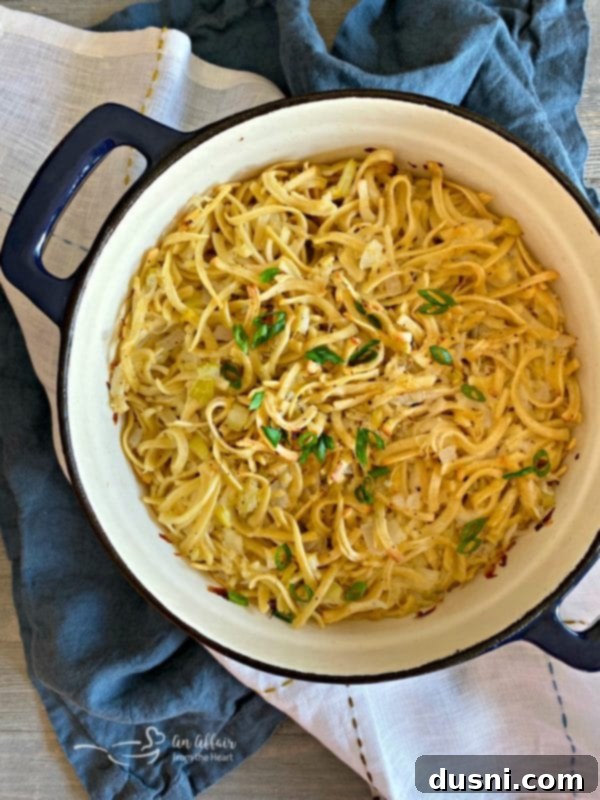
As a proud descendant of Polish heritage, I’ve always cherished the rich culinary traditions passed down through generations. However, not speaking the language fluently sometimes makes naming these wonderful dishes a bit of a delightful challenge! While traditional names like “Kluski Kapusta Kiszona” or “Polish Haluski” are beautiful and authentic, for simplicity and ease of pronunciation, I often refer to this particular recipe as “Polish Noodles & Kraut Casserole.” Rest assured, whether you call it by its traditional Polish moniker or its more common English name, the incredible flavors remain the same. This recipe perfectly encapsulates the essence of a traditional meatless Polish noodle casserole, a true staple in many homes.
This post is proudly sponsored by Frank’s Kraut. My unwavering love for their exceptional sauerkraut spans a lifetime, and all opinions expressed here are entirely my own.
SOME OF THE ITEMS BELOW CONTAIN AFFILIATE LINKS; I AM A PARTICIPANT IN THE AMAZON SERVICES LLC ASSOCIATES PROGRAM, AN AFFILIATE ADVERTISING PROGRAM DESIGNED TO PROVIDE A MEANS FOR US TO EARN FEES BY LINKING TO AMAZON.COM AND AFFILIATED SITES. I AM ALSO AN AFFILIATE FOR OTHER BRANDS. HOWEVER, I ONLY PROMOTE THINGS THAT I LOVE AND THINK YOU WILL LOVE, TOO. FOR MY ENTIRE DISCLOSURE POLICY PLEASE CLICK HERE.

As the crisp, cool autumn air begins to settle in, our thoughts naturally drift towards hearty comfort food that warms the soul. And what could be more comforting than a delectable casserole crafted from buttery egg noodles, tangy sauerkraut, and sweet caramelized onions? This particular dish is a classic “stick-to-your-ribs” kind of meal, offering immense satisfaction and a deep sense of culinary coziness. Despite being entirely meatless, it’s incredibly filling and stands perfectly well as a main course. Yet, its versatility shines when served as a flavorful side dish alongside grilled Polish sausage or a succulent roast. It’s also an absolute showstopper at potlucks and family gatherings, always receiving rave reviews and disappearing quickly!
At its core, this traditional Polish comfort food combines tender noodles, typically Kluski, pan-fried in generous amounts of butter with sautéed onions and flavorful sauerkraut. For my version, I’ve added finely chopped celery, as I find its subtle crunch and earthy notes beautifully complement the sweetness of the onion and the tang of the kraut. Some variations also include mushrooms, which lend an even deeper, savory earthiness to the dish. The dish’s varied nomenclature stems from its regional differences and linguistic roots, often leading to it being simply called “Noodles & Kraut” or “Noodles & Cabbage” in many American households.
Understanding the Traditional Names: Haluski, Kluski, Kapusta, and Kiszona
To truly appreciate this wonderful Polish Noodles & Sauerkraut Casserole, it’s helpful to understand the traditional terms that describe its key components. These names offer a glimpse into the rich culinary vocabulary of Eastern European cuisine.
What is Haluski?
Haluski is a broad term, often associated with Central and Eastern European cuisine, particularly Polish and Slovakian. It generally refers to a simple, rustic dish made with soft dumplings or noodles, often pan-fried with onions and cabbage (or sauerkraut) in butter. While Poles, Slovaks, Ukrainians, and Hungarians all lay claim to variations of Haluski, the core concept remains the same: a comforting combination of starch and sautéed vegetables. Our “Polish Noodles & Kraut Casserole” falls firmly into this delicious category.
What are Kluski? [KLOOSS-kee]
In Polish, “Kluski” is a versatile word that translates to “dumplings” or “noodles.” Kluski noodles are typically thicker and chewier than standard Italian pasta, often made from a simple dough of flour, water, and sometimes eggs. They share a close resemblance to broad egg noodles, making them largely interchangeable in recipes like this one. While true Kluski might be just flour and water, the addition of eggs in what we commonly call “egg noodles” provides a richer flavor and a slightly different texture, both of which are excellent for this casserole.
What is Kapusta? [kah-POOS-tah]
“Kapusta” is the Polish word for cabbage. When used in a culinary context, it often refers to braised cabbage dishes, typically prepared with onions, mushrooms, and garlic. It’s a fundamental ingredient in many Polish recipes, celebrated for its versatility and earthy flavor.
What is Kiszona?
The term “Kiszona” directly translates to “sour” or “pickled,” and when paired with “Kapusta,” it means “sour cabbage” or, as we know it, “sauerkraut.” This fermented cabbage adds a distinct tangy flavor and a wonderful textural contrast that is crucial to this Polish casserole. The fermentation process also infuses sauerkraut with beneficial probiotics, making it a delicious and healthy addition to any meal.
So, as you can see, understanding these terms helps to demystify the rich traditions behind this dish. For those of us who don’t speak Polish daily, simply calling it “Polish Noodles & Sauerkraut” makes perfect sense! This isn’t a dish I distinctly remember from my own childhood, at least not in this traditional casserole form. However, a delightful twist came to light recently: my daughter is engaged to a man of Polish and Lithuanian descent, and his family prepares a very similar meal every Easter, which they affectionately call “Polish Spaghetti.” It’s wonderful to see how these culinary traditions evolve and continue through generations, even with new names.

This cherished photograph captures a moment from my very first Christmas, where I’m sitting beside my maternal great-grandmother. She was a remarkable woman who emigrated to the United States from Tarnow, Poland, at the tender age of 16. Her family eventually settled in Nebraska, where she met and married my Great Grandfather and lovingly raised their family in the small town of Ashton. I distinctly recall visiting her when I was in 6th grade, not long before she passed away. She spoke very little English, so having my grandmother there to help translate our conversations was always a treasured experience. These family connections and the echoes of their traditions continue to inspire my cooking today, especially when I delve into recipes like this authentic Polish Noodles & Sauerkraut.
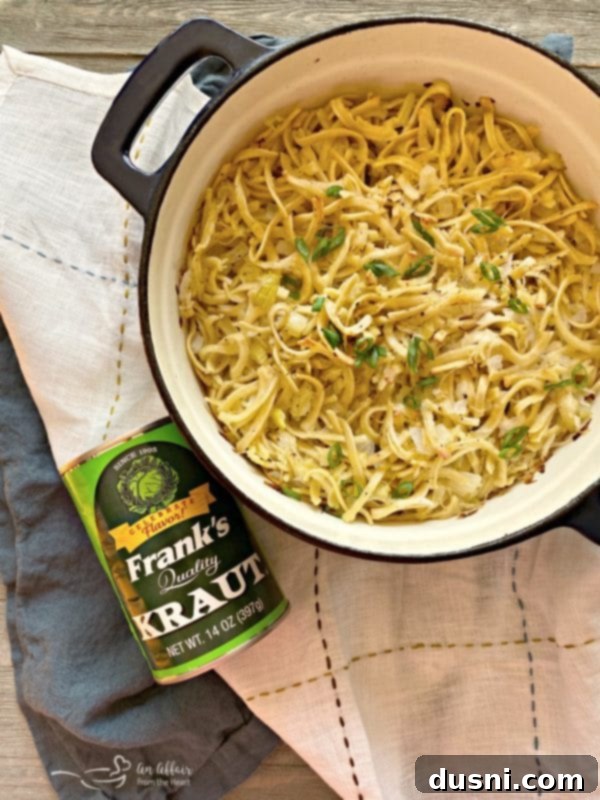
When my friends at Frank’s Kraut approached me to create a comforting, casserole-style dish perfect for ushering in the cooler temperatures, this hearty noodle dish immediately sprang to mind. Frank’s Kraut has been my go-to brand for as long as I can remember, and I’ve prepared countless recipes using their delicious sauerkraut. One of our family’s absolute favorite kraut casseroles, in addition to this one, is our incredibly popular Reuben Casserole. Their kraut truly elevates any dish it touches.
For a long time, my recipes featuring sauerkraut leaned more towards German-inspired meals, often focusing on themes like Oktoberfest. However, that began to shift significantly last month when I shared my family’s beloved Polish Sauerkraut Soup, or Kapusniak. This experience truly inspired me to dive deeper into exploring and sharing more recipes rooted in my Polish heritage. It’s been a wonderful journey of culinary discovery and reconnection with my family’s past.
Explore More Sauerkraut Recipes on My Pinterest Board!
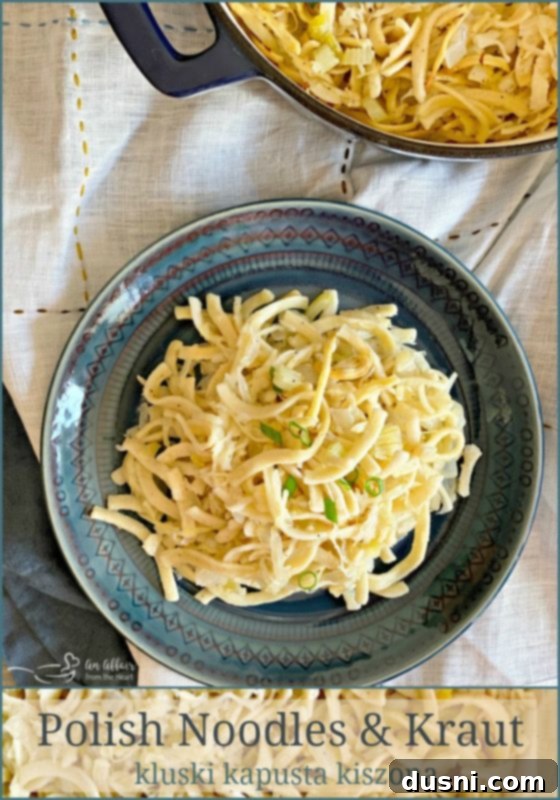
^Love this recipe? Pin it for later!^
If you’re as excited as I am to try this incredible Polish Noodles & Sauerkraut Casserole, don’t forget to pin it to your favorite Pinterest board! That way, you can easily find this comforting recipe whenever the craving strikes.
Simple, Wholesome Ingredients for Polish Noodles & Sauerkraut:
Creating this delicious Kluski Kapusta Kiszona only requires a handful of accessible and flavorful ingredients:
- Butter: Essential for sautéing and adding rich flavor to the noodles and vegetables.
- Onion: Caramelizes beautifully, providing a sweet base for the dish.
- Celery: (My personal addition!) Adds a delightful crunch and subtle earthy note that pairs wonderfully with the other ingredients.
- Frank’s Kraut: The star of the show! Its tangy flavor is irreplaceable.
- Kluski Noodles: Or wide egg noodles, providing the perfect chewy texture.
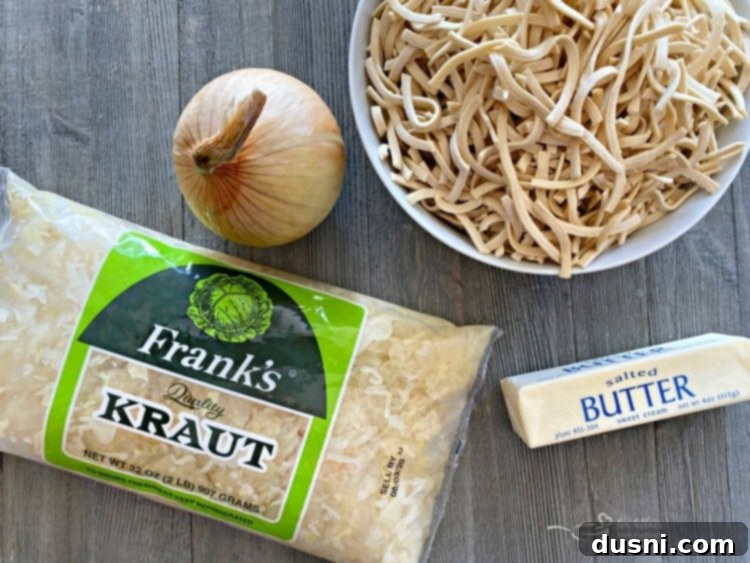
You’ll notice the celery isn’t in this particular photo; it was a last-minute addition to the recipe that I absolutely adored for its fresh, subtle flavor and texture. I highly recommend including it!
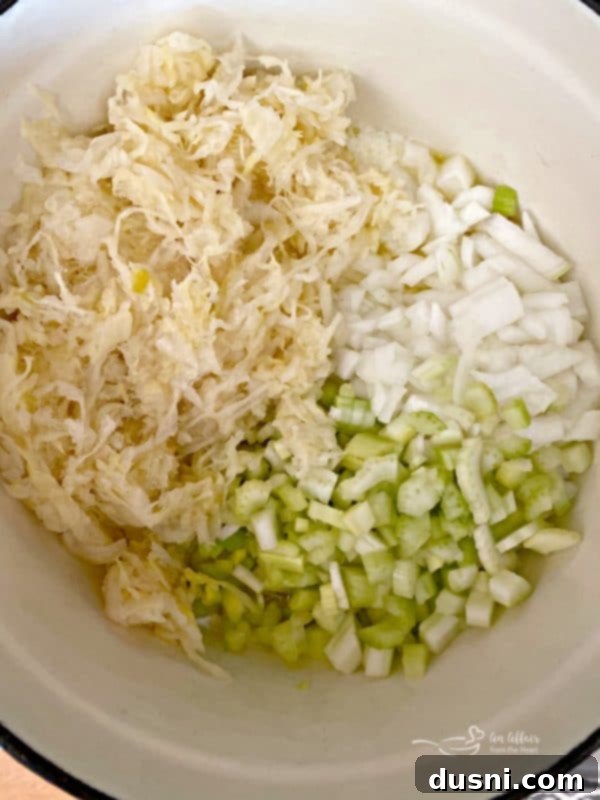
The preparation for this Polish Noodles & Sauerkraut casserole is straightforward and incredibly rewarding. Start by melting a generous amount of butter in a sturdy, oven-safe pan – my preferred choice is a cast iron Dutch oven. Using an oven-safe vessel simplifies the process, allowing you to seamlessly transition from stovetop sautéing to oven baking. Once the butter is melted and shimmering, add your chopped celery, onion, and well-drained sauerkraut. Cook this mixture gently, stirring frequently, until the onions become beautifully translucent and the celery softens. This caramelization process develops deep, complex flavors that are essential to the dish. Simultaneously, in a separate pot, cook your Kluski noodles (or broad egg noodles) according to package directions in salted boiling water until al dente, then drain them thoroughly. This ensures they are perfectly tender before being combined with the kraut mixture.

Once your vegetables are softened and your noodles are cooked, combine them in the Dutch oven. Season with a touch of salt and freshly ground black pepper to taste, then stir everything together until the noodles are thoroughly coated in the buttery sauerkraut mixture. Transfer the Dutch oven to your preheated oven and bake. During the final baking stage, a magical transformation occurs: the noodles on the top layer begin to turn a beautiful golden brown and crisp up. These slightly crunchy, caramelized bits are always the first to disappear in my family, a testament to that irresistible texture in any baked pasta dish!
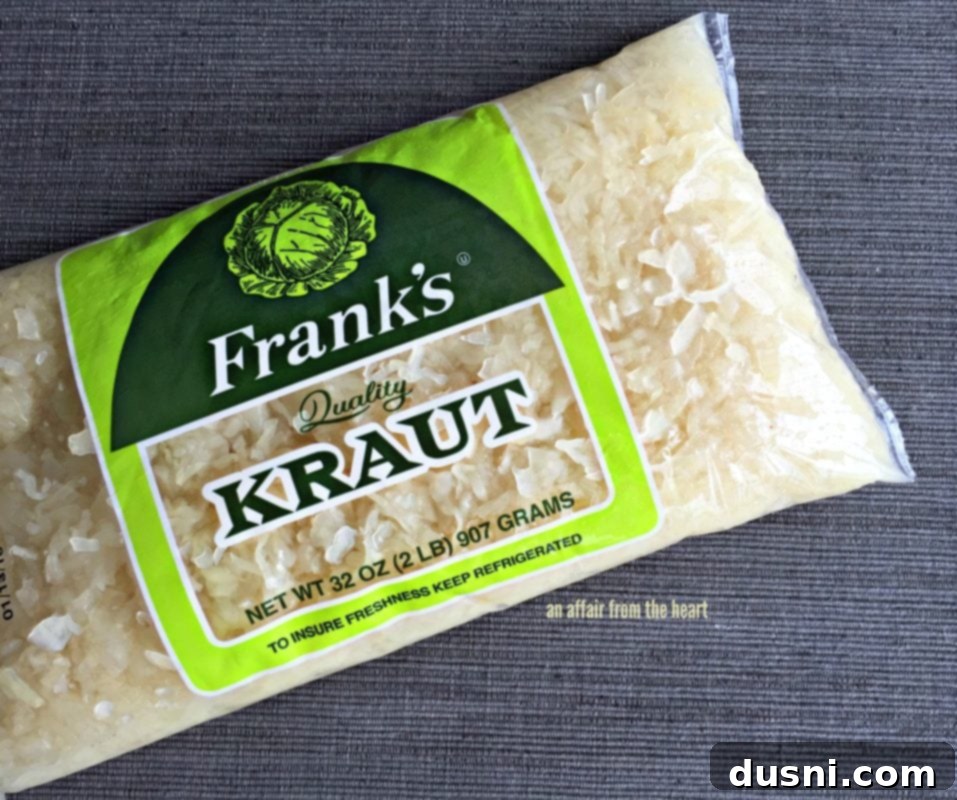
Why Frank’s Kraut is My Go-To for Authentic Flavor
Let’s take a moment to talk about my absolute favorite sauerkraut: Frank’s Kraut. This isn’t just a brand for me; it’s the taste of my childhood. It’s the only sauerkraut I’ve ever cooked with as an adult, and for good reason. Frank’s Kraut delivers consistent quality and that perfectly balanced tangy flavor that is crucial for authentic Polish dishes like our Kluski Kapusta Kiszona. The quality of your sauerkraut can truly make or break this casserole, and Frank’s never disappoints.
Frank’s Kraut is conveniently available in various formats: traditional cans, versatile jars, and my personal favorite, these poly bags. When I purchase the two-pound poly bags, I always make sure to grab a few extra to store in the freezer. (Have you ever tried frozen kraut? It’s surprisingly good!). Once defrosted, I use the amount needed for my recipe and then transfer any remaining sauerkraut into a mason jar for storage in the fridge, ensuring it stays fresh and ready for my next culinary creation.
Frank’s Kraut is truly one of the most versatile and underrated vegetables you can find on the grocery shelf. Beyond its fantastic flavor, sauerkraut is a nutritional powerhouse, providing zest and health benefits to a myriad of meals. It’s made with just three simple ingredients: cabbage, salt, and water, making it naturally low in calories and gluten-free. Plus, Frank’s offers various flavors to suit different tastes. To learn more about their products and the wonderful world of sauerkraut, be sure to visit their informative website.
A Deep Dive into the World of Sauerkraut!
Are you a fellow sauerkraut enthusiast? If so, you’ll love my comprehensive resource! Discover everything you’ve ever wanted to know about kraut – from its fascinating origins and traditional preparation methods to a treasure trove of delicious sauerkraut recipes. Dive into my Ultimate Guide to Sauerkraut, your complete resource for this amazing fermented vegetable.
Stay connected with Frank’s Kraut on their social media channels to discover a wealth of delicious recipes throughout the year. Follow them on Facebook, Twitter, Pinterest, and Instagram for all things sauerkraut!
Discover ALL of My Favorite Sauerkraut Recipes!
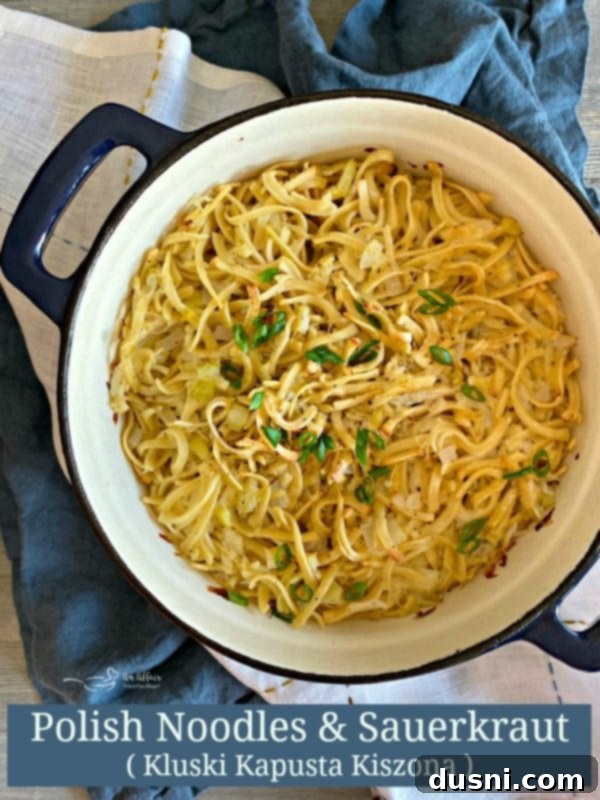
Now, let’s dive into the full recipe for this irresistible Polish Noodles & Sauerkraut (Kluski Kapusta Kiszona)! Enjoy every comforting bite! 
LIKE THIS RECIPE?
Don’t forget to give it a ⭐️⭐️⭐️⭐️⭐️ star rating and
leave a comment below the recipe!

Print Recipe
Polish Noodles & Sauerkraut ( Kluski Kapusta Kiszona )
Equipment
-
Franks Kraut, Shredded, Canned, 14-Ounce (Pack of 24)
-
Lodge 6 Quart Enameled Cast Iron Dutch Oven. Classic Red Enamel Dutch Oven (Island Spice Red)
Ingredients
- 1 stick butter
- 1 large onion chopped
- 2 cups Frank’s Kraut drained (unrinsed)
- 1/2 cup celery chopped
- 1 16 ounce package Kluski noodles, cooked
Instructions
-
Preheat oven to 350 degrees F.
-
In a Dutch oven, melt butter over medium-high heat. Add to it: sauerkraut, onion, and celery. Cook, stirring frequently until the onion is translucent and celery is cooked. About 20 minutes.
-
While sauerkraut mixture is cooking, boil your Kluski noodles in a pot of salted boiling water. Drain.
-
Stir noodles into the sauerkraut mixture.
-
Cover and bake for 30 minutes. Remove lid and bake for 15 minutes more. Noodles will begin to turn golden brown on top.
-
Serve right from the pot, top with scallions, if desired.
Notes
Nutrition
